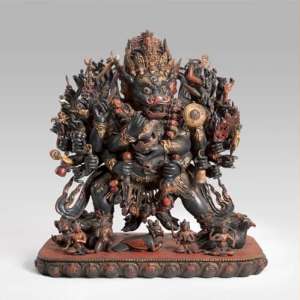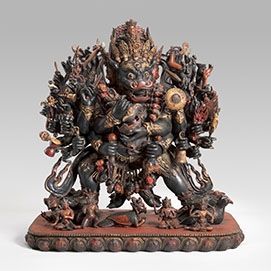
Read the transcript of this episode.
Can letting go into death be the ultimate act of awakening? In this episode we explore how the process of dying can be an act of truly living. We speak with hospice and palliative medicine physician and author BJ Miller, who discusses his first encounter with death, facing his own mortality as a triple amputee, and what it means to have a good death.
To start, BJ responds to a four-foot-tall sculpture of the fierce protector Vajrabhairava. Enormous and terrifying, he embodies the power and wisdom that can help us conquer our greatest attachment—life—and our ultimate fear—its cessation.
ABOUT THE GUEST
Dr. BJ Miller is a longtime hospice and palliative medicine physician. He currently sees patients and families via telehealth through Mettle Health, a company he co-founded with the aim to provide holistic care for individuals and families who need help navigating the practical, emotional,and existential issues that come with serious illness and disability.
Led by his own experiences as a patient, BJ advocates for the roles of our senses, community,and presence in designing a better ending. His interests are in working across disciplines to affect broad-based culture change, as well as furthering the message that suffering, illness, and dying are intrinsic aspects of life.BJ has given over 100 talks on the topics of death, dying, palliative care,and the intersection of healthcare with design.
ABOUT THE ART FROM THIS EPISODE

This monumental wooden sculpture embodies the victory over death expressed in the wrathful deity’s epithet, Slayer of Yama (Yamantaka). The true identity of this figure is revealed by his uppermost head, whose peaceful expression is that of the deity embodying wisdom, Manjushri. As explained in texts on meditative practices focused on this deity, there was a time when the Lord of Death, Yama, was rampaging and causing unimaginable suffering. Manjushri decided to tame this god and end the suffering. He confronted Yama, transforming himself into a mirror image of the Lord of Death, with all of his terrifying powers, and thus forced Yama to encounter himself. Yama swore to serve the cause of this wisdom by reminding all beings of impermanence and the interconnected nature of all things that have a cause. Wisdom overcomes death by making us face reality and ourselves.
PRODUCTION CREDITS
AWAKEN is produced by the Rubin Museum of Art with Vincent Baker, Dawn Eshelman, Jamie Lawyer, Sandrine Milet, Elena Pakhoutouva, and Dawnette Samuels. It was produced in collaboration with Sound Made Public, with Tania Ketenjian, Katie McCutcheon, and Philip Wood.
Special thanks to Karen Sorensen for additional consulting.
All music for AWAKEN was created by Blue Dot Sessions, Podington Bear, Tendinite, and Siddhartha Corthus.
OUR GENEROUS SUPPORTERS
This podcast is supported by Barbara Bowman, the Ellen Bayard Weedon Foundation, The Prospect Hill Foundation, Bob and Lois Baylis, public funds from the New York City Department of Cultural Affairs in partnership with the City Council, and by the New York State Council on the Arts with the support of Governor Andrew M. Cuomo and the New York State Legislature, as well as by generous donations from the Museum’s Board of Trustees, individual donors, and members.
AWAKEN is sponsored by Tricycle: The Buddhist Review, a print and digital magazine dedicated to making Buddhist teachings broadly available.




